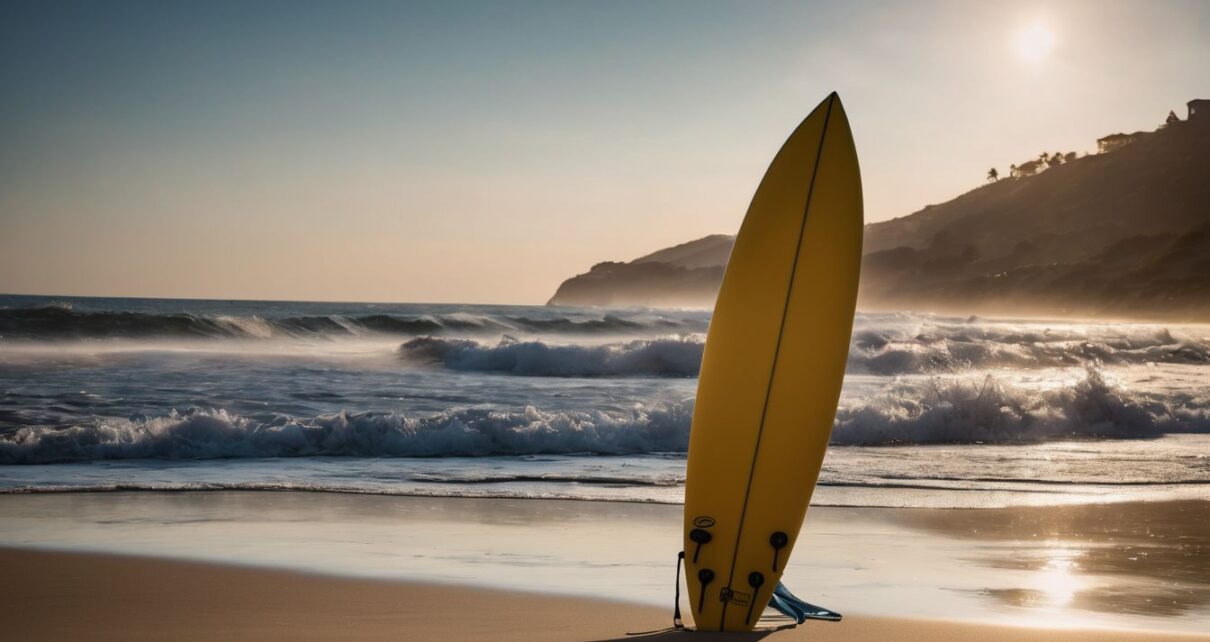Craving the thrill of riding ocean waves? Surfing is a beloved sport with roots deep in Hawaiian culture, now celebrated worldwide. This guide promises to break down everything from catching your first wave to standing tall on the board like a pro.
Get ready to dive in!
Key Takeaways
- Surfing is a dynamic ocean sport with roots in Hawaiian culture that combines athletic skill and an intimate understanding of the sea’s patterns.
- The activity extends beyond just the sport, offering benefits like stronger muscles, stress relief, and fostering connections with nature and community.
- There are different styles of surfing to suit various preferences, including freestyfing for fun or competition surfing for those who enjoy challenges.
- Top global destinations for surfers include Hawaii, Australia, Indonesia, California, South Africa, and Costa Rica; each offers unique waves and experiences.
- Preparing to surf involves selecting proper gear like wetsuits and boards while considering safety through lessons and understanding wave conditions.
What is Surfing?

Surfing is an exhilarating ocean sport where individuals, known as surfers, ride the waves on a special board called a surfboard. The goal is to stay upright and travel along the wave’s face before it breaks and loses its energy.
It blends athletic skill with an understanding of the ocean’s rhythms and patterns. Surfers apply various techniques to maneuver their boards, using body movements to guide themselves across the water.
This activity goes beyond sports; it encompasses a distinct culture involving music, fashion, art, and even language that revolves around the surfing lifestyle. From casual beach-goers to professional athletes competing in surfing competitions, this sport attracts people from all walks of life.
Additionally, surfing has solidified its place in history since ancient times and continues to influence many aspects of modern society including leisure activities and the apparel industry through brands dedicated solely to surf-related products.
The Perks of Spending Time on the Ocean While Surfing

Transitioning from the basics of wave riding, let’s dive into the benefits that come with engaging in ocean activities like surfing. Paddling out to catch waves isn’t just an exhilarating experience; it offers a unique mix of physical and mental perks.
Strong shoulders and core muscles are built through paddling and maintaining balance on the board, turning surfers into athletes with improved strength and endurance. The ocean itself serves as a natural stress reliever, with the soothing sounds of water and rhythmic movement of waves helping clear your mind.
Surf culture also promotes a deep connection with nature. Surfers gain an appreciation for marine life and become advocates for ocean conservation due to their close interactions with this environment.
Additionally, being part of beach lifestyle communities fosters lifelong friendships centered around shared passions for coastal pastimes and aquatic recreation. Whether you’re freestyling away from competition or simply enjoying leisure time on the water, surfing enriches lives beyond just riding epic swells.
https://www.youtube.com/watch?v=TovopBnT1aw
Types of Surfing
Surfing isn’t just one sport; it’s a variety of styles and techniques that cater to different preferences and wave conditions. Each type offers a unique way to ride the waves, showcasing the surfer’s skills and creativity.
- Freesurfing: This casual surfing style encourages individual expression, where surfers aren’t bound by competition rules. Surfers focus on having fun and improving their skills, all while respecting the unspoken etiquette of giving way to the one nearest the breaking wave’s peak.
- Competition Surfing: In this more structured approach, surfers showcase their talents under pressure. They perform in timed heats against others, seeking to impress judges with their technique and flair within set time limits.
- Shortboarding: Defined by agility and speed, shortboarding demands precision from surfers. Riders execute tight turns and quick maneuvers, often aiming for aerial tricks on relatively small boards.
- Longboarding: Echoing surfing’s historical roots, longboarding prioritizes grace over adrenaline. Surfers glide along waves with poised control, making use of longer boards to walk its length or hang ten at the nose.
- Towing-In Surfing: Big wave enthusiasts rely on towing to face giants. A partner uses a jet ski to tow the surfer into waves too large and swift to paddle into, setting the stage for epic rides on massive swells.
https://www.youtube.com/watch?v=oWDtFbdHzBE
The Basics of Surfing
Surfing involves riding waves standing up on a surfboard, using different types of surfboards. The sport dates back to ancient Hawaiian culture and has evolved into a widespread ocean activity with its own distinct lifestyle.
Whether you prefer longboards or shortboards, surfing offers something for everyone, from the thrill-seekers chasing big waves to those simply looking to enjoy the beach life.
Learning how to catch and ride a wave is relatively easy and can be done through educational materials or professional schools. People of all ages can enjoy this exhilarating water sport while connecting with nature and living an active, beach-oriented lifestyle.
Mastering the basics of surfing opens up a world of adventure on the open ocean.
After gaining an understanding of the essentials in surfing, let’s dive into top surfing destinations around the globe.
Top Surfing Destinations
- Hawaii: Known for its legendary surf spots like Pipeline, Sunset Beach, and Waimea Bay.
- Australia: Offers diverse surfing experiences from the famous breaks of Bells Beach to the pristine waves at Gold Coast.
- Indonesia: Attracts surfers with its stunning beaches and world-class waves in places like Bali and Mentawai Islands.
- California: Boasts iconic surf destinations such as Malibu, Trestles, and Mavericks for a variety of surfing experiences.
- South Africa: Offers outstanding surfing opportunities with renowned spots like Jeffrey’s Bay and Dungeons.
- Costa Rica: Known for its consistent waves along both the Pacific and Caribbean coasts, attracting surfers from around the globe.
These exceptional destinations are sure to offer unforgettable experiences for any avid surfer.
Famous Surfers and Events
Some notable surfers in the sport are Kai Lenny, Carissa Moore, Caroline Marks, Jordy Smith, and Kanoa Igarashi. Surfing events include the Pipe Masters, WSL Finals, Surf Ranch Pro, Nazaré Tow Surfing Challenge, Triple Crown of Surfing, Jaws Big Wave Championships, and Red Bull Cape Fear.
These athletes and events showcase the thrill and skill involved in professional surfing across a variety of competitions and challenges around the world.
How to Prepare for Surfing
To prepare for surfing, it’s important to gather the necessary equipment and consider safety measures. Here are some essentials:
- Wetsuit: A snug-fitting wetsuit helps keep you warm in cold waters.
- Surfboard: Choose a board suitable for your skill level and the type of waves you’ll be surfing.
- Leash: Attaching the leash to your ankle prevents the board from drifting away if you fall off.
- Sunscreen: Apply a waterproof sunscreen with high SPF to protect your skin from sunburn.
- Rash guard: Wearing a rash guard minimizes chafing caused by the surfboard and protects against sun exposure.
- Surf lesson: Consider taking lessons from a professional instructor to learn proper techniques and safety guidelines.
- Beach towel: A quick-drying, absorbent towel is handy for drying off after surfing sessions.
- Surf forecast: Check the local surf forecast to understand wave conditions before heading out.
- Paddle out: Practice paddling techniques in calm waters before venturing into the surf zone.
- Swell size: Understanding swell size helps determine wave height and surf difficulty levels.
Conclusion
In conclusion, surfing is an exhilarating sport that offers a unique connection to the ocean. It encompasses various types such as shortboarding and longboarding, each with its own set of skills and techniques.
From famous surfers to top destinations and surfing etiquette, this comprehensive guide equips you with all the essential knowledge to embark on your surfing journey. Whether you’re a beginner or looking to improve your skills, the world of surfing awaits with endless waves of excitement and adventure.
So grab your board, hit the waves, and experience the sheer joy of riding nature’s ultimate rollercoaster.
FAQs
1. How do I choose the right surfboard for beginners?
For beginners, it’s best to start with a long, thick, and stable soft-top surfboard that provides buoyancy and stability in the water.
2. What are the essential safety tips for surfing?
Essential safety tips include always using a leash to keep your board close, being aware of rip currents, respecting other surfers’ space, and avoiding surfing alone.
3. Can anyone learn how to surf regardless of age?
Yes, anyone can learn how to surf regardless of age as long as they are physically fit and comfortable swimming in the ocean.
4. How should I prepare for my first surfing lesson?
Prepare for your first surfing lesson by applying sunscreen, staying hydrated, wearing a rash guard or wetsuit (if needed), and arriving with a positive attitude and willingness to learn.
5. How important is understanding wave dynamics in surfing?
Understanding wave dynamics is crucial in surfing as it helps you anticipate waves, position yourself properly on them, and improve your overall performance.



